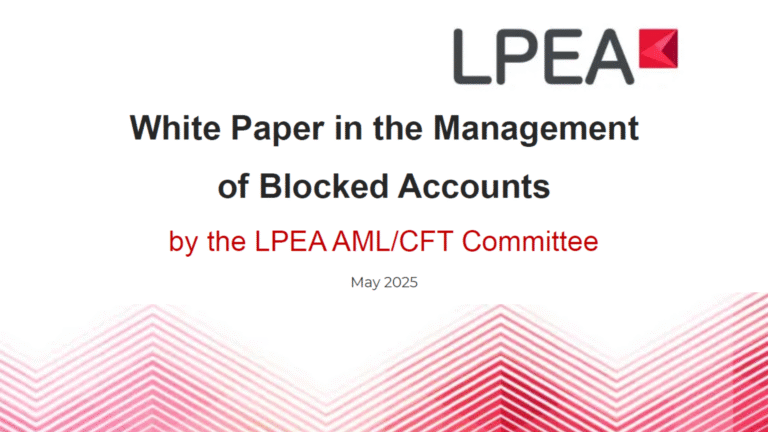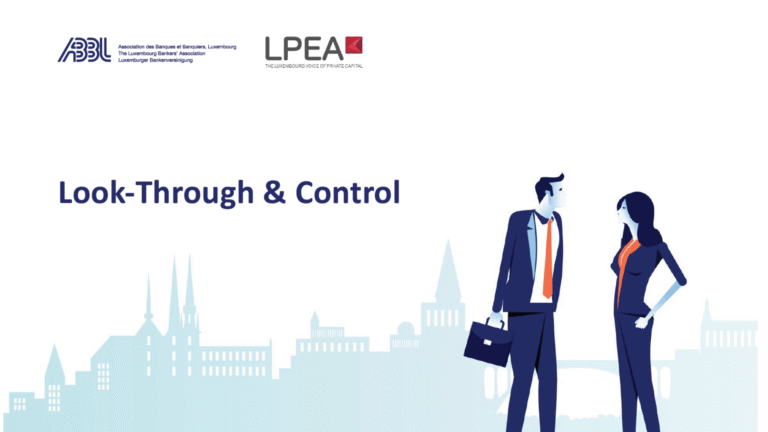Written by the LPEA Legal – Unregulated/Regulated Funds Committee
On 24 July 2023, the new Luxembourg law of 21 July 2023 bringing substantial amendments to the SICAR Law[1], the SIF Law[2], the UCI Law[3], the RAIF Law[4] as well as the AIFM Law[5] (together the Product Laws), was published in the Luxembourg official journal (Mémorial A N°442 of 24 July 2023) (the Amending Law).
The Amending Law modernizes and improves the existing Luxembourg investment funds toolbox. Priorities set for this upgrade of tried and tested fund regimes were twofold: removing some pending hurdles to facilitate the day-to-day management of funds and bringing them at par with competing products in other fund jurisdictions, particularly in the context of the recent “retailisation” initiatives supported by the EU (through ELTIF 2.0[6]), marked in Luxembourg by a strong uptick of Part II UCIs and ELTIFs applications over the last few months. The Amending Law entered into force on 28 July 2023.
The most significant amendments are outlined hereafter:
1. Amendments to the Product Laws
The Amending Law is bringing further consistency across the Product Laws with some targeted amendments on the following topics:
- Investor eligibility conditions. The minimum investment threshold regarding well-informed investors in SIFs, SICARs and RAIFs has been reduced from EUR 125,000 to EUR 100,000, bringing it in line not only with the eligibility requirements for some European fund labels (EUSEF[7], EUVECA[8]) but also with the local placement regimes for marketing to non-professional investors in certain EU countries and with the Prospectus Regulation[9] exemption applicable to any offer with a ticket size below EUR 100,000. This should facilitate the on-boarding of a broader range of investors for all those fund regimes.
- Timeframe for reaching minimum capital. The Amending Law doubles the timeframe within which SIFs, RAIFs, and SICARs (24 months) and Part II UCIs (12 months) must reach the prescribed minimum capital. This is a welcomed improvement if and when navigating a difficult fundraising environment such as currently.
- New regime for the depositary replacement. The previous 2 months maximum time window to replace the depositary of SIFs, SICARs, Part II UCIs or UCITS following termination of the depositary agreement is removed. The rules as refreshed now provide that the depositary agreement has to provide for a notice period by the end of which the new depositary shall be appointed. The fund will be withdrawn from the relevant CSSF official list on which it is registered if the replacement fails to complete by the end of the notice period. This change is meant to avoid any time lag where no depositary is appointed.
- Extension of the prohibition to issue or redeem units/interests under certain cases. The issuance and redemption of shares/interests is not allowed when there is no longer a depositary, or when the latter is in liquidation, declared bankrupt or undergoing a suspension of payments, an arrangement with its creditors or some other type of management supervision. An exception is provided where such actions are necessary for the purpose of the liquidation proceedings. Any subscription or redemption of fund interest can therefore not happen without a depositary properly overseeing the process in the interest of investors.
- Residual duties of the depositary of a fund in liquidation. The Product Laws (with the exception of the RAIF Law) now include a specific mention of the mandatory residual duties incumbent upon depositaries during the liquidation process, regardless of whether a depositary agreement is still in force during the liquidation process. This amendment solves the legal uncertainty that remained around the applicable duties of the depositary when a fund enters into a liquidation process, which often also triggers an automatic termination of the depositary agreement.
2. Further specific amendments to the Part II UCI regime
The Amending Law provides increased flexibility when structuring Part II UCIs by introducing, among others, the following changes:
- Extension of available legal forms for Part II UCIs. Part II UCIs opting for a corporate form as a SICAV are no longer obliged to be incorporated as public limited liability company (SA) which was the one and only option to date. The range of available legal forms is extended to corporate partnerships limited by shares (SCA), common and special limited partnerships (SCS/SCSp), private limited liability companies (SARL), as well as cooperatives organized as public companies limited by shares (SCoSA). This is a game changer for alternative asset managers who can now replicate popular partnership structures used for professional/institutional investors when tapping into the retail market.
- Broadening of the issue price determination mechanics. Closed-ended Part II UCIs are now authorized to issue shares/interests for a price other than NAV if so provided in their constitutive documents. This now allows Part II UCIs to conform with the well-established private equity market practice of issuing shares/interests at a fixed price throughout the term of the fund (subject to an equalization interest paid by subsequent investors joining after the first closing).
3. Further specific amendments to the RAIF regime
The Amending Law further brings some technical amendments specific to RAIFs:
- Revamp / lightening of the establishment process. Only RAIFs formed under private deeds are now required to obtain a notarial acknowledgement that they have been established as a RAIF and that an AIFM has been duly appointed, within five days from their establishment (the so-called “RAIF constat”).
- Confirmation that RAIFs can be marketed to non-professional investors in Luxembourg. It has been clarified that RAIFs can be marketed to non-professional investors in Luxembourg, provided they qualify as well-informed investors.
- Maintenance of up-to-date information on the RAIF list. As a matter of good governance and consistency, RAIFs are now required to inform the RCS within twenty (20) business days of any amendment to the information previously communicated to the RCS as part of the registration process on the official RAIF list.
4. Specific amendments to AIFMs and Management Companies regimes
The Amending Law brings consistency across the rules applicable to AIFMs and management companies of UCIs on a few technical aspects.
- Rules on judicial liquidation for AIFMs and management companies of UCIs aligned. The Amending Law provides that once notified of its withdrawal from the CSSF official list, an AIFM is no longer allowed to proceed to any legal act, except conservatory acts until its liquidation decision is formally taken (unless otherwise authorised to do so by a supervisory commissioner). One or more supervisory commissioners are appointed by the Tribunal d’Arrondissement (District court) for this purpose. The Commissioner(s) exercise(s) his/their function until the dissolution and opening of liquidation of the entity. In case of liquidation, the court must receive a report from the supervisory commissioner regarding the usage of the AIFMs assets prior to the designation of the liquidator. The same rules have been included in the SIF Law and the SICAR Law and are applicable, respectively, to SIFs and SICARs.
- Voluntary liquidation for AIFMs. The Amending Law introduces new rules on the voluntary liquidation of AIFMs. For the purpose of its liquidation, an AIFM is deemed to exist after its dissolution. The proposed liquidator(s) must be approved by the CSSF and the decision to liquidate the AIFM can only be taken once all management activities have stopped. The legal framework related to the voluntary liquidation of management companies of UCIs, which was already in existence, is also amended in order to be aligned with the new regime governing AIFMs.
- AIFMs allowed to use tied agents. AIFMs established in Luxembourg will be allowed to appoint tied agents as defined in the Law of 5th April 1993 on the financial sector, as amended (the ‘’1993 Law’’). AIFMs appointing a tied agent must comply with the duties laid down in the 1993 Law. Within the limits of its permitted activities under the AIFM Law, the AIFM remains fully and unconditionally responsible for any action or omission on the part of the tied agent when acting on behalf of the AIFM and it shall monitor the activities of the appointed tied agent to ensure compliance with applicable requirements.
- New requirements for own funds. The Amending Law introduces new own fund requirements for management companies of UCIs, matching the rules applicable to AIFMs. Own funds must be invested in liquid assets or in assets that are easily convertible in short term liquidities, and speculative positions with their own funds should be avoided. Where the requirements related to own funds are not met by the management companies of UCIs governed by Chapter 16 of the UCI Law, an additional deadline by the CSSF may be granted in order to comply with the legal requirements.
5. Exemption of subscription tax extended to ELTIFs and PEPPs
The Amending Law exempts from subscription tax any SIF, RAIF or Part II UCI authorised as ELTIF or reserved to individual investors acting through a pan-European Personal Pension Product (PEPP). This again should make Part II UCIs authorised as ELTIFs particularly attractive when embarking on a retail AIF project and potentially set them apart from competing products in other jurisdictions.
[1] The law on the law of 15 June 2004, as amended, relating to the investment company in risk capital, as amended (the SICAR Law).
[2] The law of 13 February 2007, as amended, relating to specialized investment funds, as amended (the SIF Law).
[3] The law of 17 December 2010, as amended, on undertakings for collective investment, as amended (the UCI Law).
[4] The law of 23 July 2016, as amended, on reserved alternative investment funds, as amended (the RAIF Law).
[5] The law of 12 July 2013, as amended, on alternative investment fund managers, as amended (the AIFM Law).
[6] Regulation (EU) 2023/606 of the European Parliament and of the Council of 15 March 2023 amending Regulation (EU) 2015/760 as regards the requirements pertaining to the investment policies and operating conditions of European long-term investment funds (ELTIFs) and the scope of eligible investment assets, the portfolio composition and diversification requirements and the borrowing of cash and other fund rules (ELTIF 2.0).
[7] European social entrepreneurship fund (EUSEF) withing the meaning of Regulation (EU) 346/2013 of the European Parliament and of the Council of 17 April 2013 on EUSEF, as amended.
[8] European venture capital fund (EUVECA) withing the meaning of Regulation (EU) 345/2013 of the European Parliament and of the Council of 17 April 2013 on EUVECA, as amended.
[9] Regulation (EU) 2017/1129 of the European Parliament and of the Council of 14 June 2017 on the prospectus to be published when securities are offered to the public or admitted to trading on a regulated market, and repealing Directive 2003/71/EC (the Prospectus Regulation).




